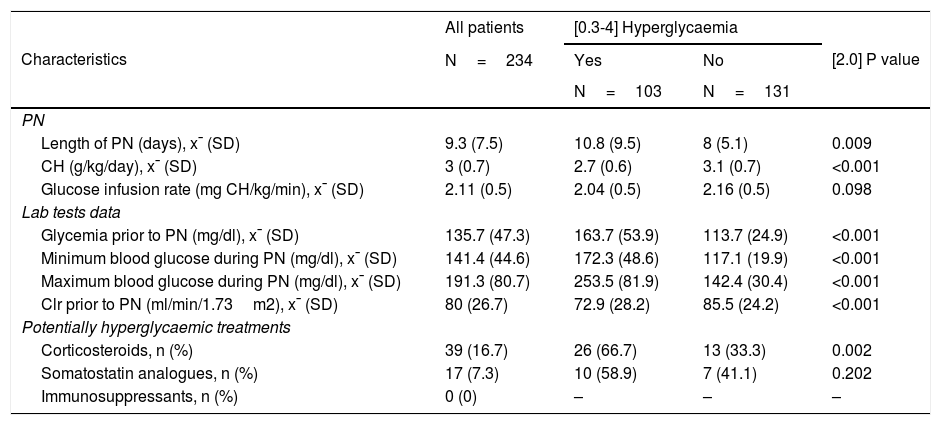To identify the predictive factors of hyperglycaemia in patients receiving parenteral nutrition (PN).
Material and methodsRetrospective observational study (January 2016- December 2016) conducted in a 450-bed university hospital. Adult hospitalized patients who received total PN through a central line for at least 48h were included. The required variables to characterize patients, and those related to the PN received were collected and hyperglycaemia was defined as three consecutive glycaemias greater than 150mg/dl or two greater than 180mg/dl. A descriptive, comparative bivariate statistical analysis was carried out, as well as a multivariate analysis using binary logistic regression (SPSS.v.24.).
Results234 patients were included. The prevalence of hyperglycaemia in the population under study was 44.0%. The main differences observed in the bivariate analysis between hyperglycaemic and normoglycemic patients were related to age, previous comorbidities, medical department, presence of sepsis, duration and glucose contribution in PN, as well as blood glucose levels and corticosteroids. The predictors of hyperglycaemia obtained after the multivariate analysis were: renal clearance (OR=.982, 95% CI .968–0.996, p=.010), pre-PN glycaemia (OR=1.039, 95% CI 1.026–1.051 p<.001), diabetes mellitus (OR=11.016, 95% CI 3.028–31.697, p<.001), intensive medicine (OR=3.303, 95% CI 1.183–9.219 p=.023), corticosteroids (OR=3.155, 95% CI 1.179–8.226, p=.022).
ConclusionsDecreased renal clearance, high blood glucose levels, diabetes, corticosteroid use, and critical patients are predictors of hyperglycaemia, therefore it would be advisable to consider them in the design of PN start formula.
Identificar los factores predictivos de hiperglucemia en pacientes que reciben nutrición parenteral (NP).
Material y métodosEstudio observacional retrospectivo (Enero 2016- Diciembre 2016) realizado en un hospital universitario de 450 camas. Se incluyeron los pacientes adultos hospitalizados que recibieron NP total por vía central durante al menos 48 horas de duración. Se recogieron las variables necesarias para caracterizar a los pacientes, y aquellas referentes a la NP recibida y se definió hiperglucemia como tres glucemias consecutivas superiores a150mg/dL o dos superiores a 180mg/dL. Se realizó un análisis estadístico descriptivo, comparativo bivariante, y un análisis multivariante mediante regresión logística binaria (SPSS.v.24.).
ResultadosSe incluyeron 234 pacientes. La prevalencia de hiperglucemia en la población a estudio fue del 44.0%.Las principales diferencias observadas en el análisis bivariante entre los pacientes hiperglucémicos y normoglucémicos se relacionaron con edad, comorbilidades previas, servicio médico, presencia de sepsis, duración y aporte de glucosa en la NP, así como los valores analíticos de glucemia y el tratamiento con corticoides. Los factores predictivos de hiperglucemia obtenidos tras el análisis multivariante fueron: aclaramiento renal OR=0,982; IC95% 0,968-0,996;p=0,010, glucemia previa a la NPOR=1,039; IC95%1,026-1,051 p<0,001, diabetes mellitus OR=11,016; IC95% 3,028-31,697; p<0,001, medicina intensiva OR=3,303; IC95% 1,183-9,219 p=0,023, corticoides OR=3,115; IC95% 1,179-8,226; p=0,022.
ConclusionesEl aclaramiento renal disminuido, la glucemia previa elevada, la diabetes, la utilización de corticoides y el paciente crítico son factores predictores de hiperglucemia, por lo que sería conveniente considerarlos en el diseño de la fórmula de inicio de NP.









